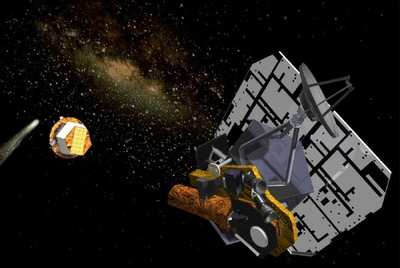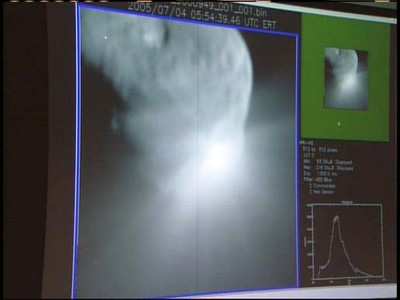Deep Impact Kicks Off Fourth Of July With Deep Space
Fireworks
After 172 days and 431 million kilometers (268 million miles) of
deep space stalking, Deep Impact successfully reached out and
touched comet Tempel 1. The collision between the coffee
table-sized impactor and city-sized comet occurred at 0152 EDT.

"What a way to kick off America's Independence Day," said Deep
Impact Project Manager Rick Grammier of NASA's Jet Propulsion
Laboratory, Pasadena, CA. "The challenges of this mission and
teamwork that went into making it a success, should make all of us
very proud."
"This mission is truly a smashing success," said Andy Dantzler,
director of NASA's Solar System Division. "Tomorrow and in the days
ahead we will know a lot more about the origins of our solar
system."

Official word of the impact came 5 minutes after impact. At 0157
EDT, an image from the spacecraft's medium resolution camera
downlinked to the computer screens of the mission's science team
showed the tell-tale signs of a high-speed impact.
"The image clearly shows a spectacular impact," said Deep Impact
principal investigator Dr. Michael A'Hearn of the University of
Maryland, College Park. "With this much data we have a long night
ahead of us, but that is what we were hoping for. There is so much
here it is difficult to know where to begin."

The celestial collision and ensuing data collection by the
nearby Deep Impact mothership was the climax of a very active 24
hour period for the mission which began with impactor release at
0207 EDT on July 3. Deep space maneuvers by the flyby, final
checkout of both spacecraft and comet imaging took up most of the
next 22 hours. Then, the impactor got down to its last two hours of
life.
"The impactor kicked into its autonomous navigation mode right
on time," said Deep Impact navigator Shyam Bhaskaran, of JPL. "Our
preliminary analysis indicates the three impactor targeting
maneuvers occurred on time at 90, 35 and 12.5 minutes before
impact."
At the moment the impactor was vaporizing itself in its 10
kilometers per second (6.3 miles per second) collision with comet
Tempel 1, the Deep Impact flyby spacecraft was monitoring events
from nearby. For the following 14-minutes the flyby collected and
downlinked data as the comet loomed ever closer. Then, as expected
at 2:05 a.m. EDT, the flyby stopped collecting data and entered a
defensive posture called shield mode where its dust shields protect
the spacecraft's vital components during its closest passage
through the comet's inner coma. Shield mode ended at 0232 EDT when
mission control re-established the link with the flyby
spacecraft.

"The flyby surviving closest approach and shield mode has put
the cap on an outstanding day," said Grammier. "Soon, we will begin
the process of downlinking all the encounter information in one
batch and hand it to the science team."
The goal of the Deep Impact mission is to provide a glimpse
beneath the surface of a comet, where material from the solar
system's formation remains relatively unchanged. Mission scientists
expect the project will answer basic questions about the formation
of the solar system, by offering a better look at the nature and
composition of the frozen celestial travelers known as comets.
 A Crazy Tesla Flying Car is Coming
A Crazy Tesla Flying Car is Coming ANN's Daily Aero-Term (11.xx.25): NonApproach Control Tower
ANN's Daily Aero-Term (11.xx.25): NonApproach Control Tower Aero-News: Quote of the Day (11.01.25)
Aero-News: Quote of the Day (11.01.25) ANN's Daily Aero-Linx (11.01.25)
ANN's Daily Aero-Linx (11.01.25) Classic Aero-TV: EAA Introduces Angle of Attack Training
Classic Aero-TV: EAA Introduces Angle of Attack Training






